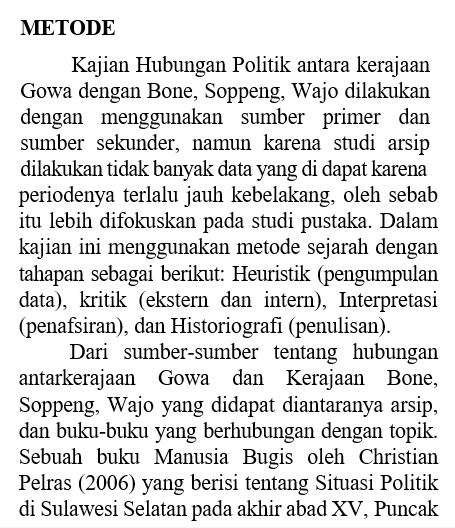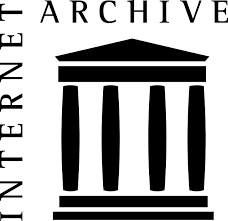Dinamika Politik di antara Kerajaan-Kerajaan
Gowa, Bone, Soppeng, dan Wajo (Tellumpocco)
DOI:
https://doi.org/10.36869/Keywords:
Hubungan politik, Gowa, Bone, Soppeng, WajoAbstract
This study aims to explain the relationships between the Kingdoms of Gowa with Bone, Soppeng, Wajo. This study uses the historical method through four stages, namely: heuristic, criticism, interpretation, and historiography, the explanation using descriptive analytical. The result of the research shows that there is a political relationships between Gowa with Bone, Soppeng, Wajo. The relationships between Gowa with Bone, Soppeng, Wajo began when Gowa became a big kingdom, so that with its strength and greatness it succeeded in conquering other kingdoms including the kingdoms of Bone, Soppeng, Wajo. Even Bone, Soppeng, and Wajo formed a partnership (Tellumpocco) to face Gowa, but to no avail. From these there kingdoms, Wajo was very loyal and obedient in establishing relations with Gowa, although at first Wajo fought against Gowa with the help of Bone and Soppeng, but Gowa was invincible. So that Wajo became an ata (slave) to Gowa. Even the three kingdoms were attacked (musu selleng) by Gowato embrace Islam. In subsecquent developments Bone defeated Gowa in the Makassar War, making Bone a major kingdom in South Sulawesi. The defeated of Gowa by Bone and its allies ended with the Bungaya Agreement. The political hegemony between Gowa and Bone who wanted to be the sole ruler in South Sulawesi, so that both of them were always at odds and engaged in war.
References
Abidin, Zainal, 1985. Wajo Abad XV-XVII, Suatu Penggalian Sejarah Terpendam Sulawesi Selatan Dari Lontarak. Bandung: Alumni.
Andaya, Leonard Y. 2013. Warisan Arung Palakka, Sejarah Sulawesi Selatan Abad Ke 17. Makassar: Ininnawa.
Bahtiar. 2017. Hubungan Antar Kerajaan: Gowa dengan Wajo. Makassar: Jurnal Pa- ngadereng, Vol 3. No.2, Desember 2017.
C, Skinner (ed). 1963. Syair Perang Makassar (The Rhymed Chronicle of the Makassar war) by Entji Amin, s-Gravenhage: Martinus Nijhoff.
Hamid, Abdullah, dkk. 2007. Sejarah Bone. Watampone: Dinas Kebudayaan Dan Pariwisata.
Mappangara, Suriadi. 2016. Filosofi Arung Palakka. Yogyakarta: Ombak
Mattulada. 1982. Menyusuri Jejak Kehadiran Makassar Dalam Sejarah (1510-1770). Jakarta: Bhakti baru-Berita Utama
. 1998.Sejarah, Masyarakat, Dan Kebudayaan Sulawesi Selatan. Makassar: Hasanuddin University Press.
M. D, Sagimun. 1992. Sultan Hasanuddin, Ayam Jantan Dari Ufuk Timur. Jakarta: Balai Pustaka.
Noorduyn, J. 1955. Een Achtiende-ceuwese kroniek van Wadjo, Buginese Histori- ografie, s-Gravenhage: N.V. De Neder- landsche Boek-en Stendrukkerij v.h. H.
L. Smits.
Patunru, Abdul Razak Daeng. 1983. Sejarah Gowa. Makassar: Yayasan Kebudayaan Sulawesi Selatan.
Sejarah Wajo. Makassar: Yayasan Kebudayaan Sulawesi Selatan.
Pelras, Christian. 2006. Manusia Bugis. Jakarta: Nalar bekerjasama Forum Jakarta-Paris.
. Sulawesi Selatan Sebelum Datang- nya Islam Berdasarkan Kesaksian Bangsa Asing, dalam Gilbert harmonic, ed. Citra Masyarakat Indonesia. Jakarta: Sinar Harapan.
Poelinggomang, Edward L, dkk. 2004. Sejarah Sulawesi Selatan Jilid 1. Makassar: Badan Penelitian Dan Pengembangan Daerah (Balitbangda) Provinsi Sulawesi Selatan.
Purnama, H.L. Kerajaan Gowa, Masa Demi Masa Penuh Gejolak. Makassar: Arus Timur
Sutherland, H.A, 1979. Between Conflict and Accomodation; History Collonialsm, Politics and Southeast Asia. Amsterdam: Vrije Universiteit.
Syarifuddin, Amier. 1989. Perjanjian Antar- kerajaan Menurut Lontarak. Ujung Pandang: Disertasi Pascasarjana Universitas Hasanuddin.
Walhoff, G.J dan Abdurrahim, tt.Sejarah Gowa.
Makassar: Yayasan Kebudayaan.
Yasin Limpo, Sahrul, dkk. 1995. Profil Sejarah, Budaya, dan Pariwisata Gowa. Ujung Pandang: Pemda Gowa bekerjasama yayasan Eksponen 1966 Gowa.

Downloads
Published
Issue
Section
License
Copyright (c) 2025 Bahtiar Bahtiar (Author)

This work is licensed under a Creative Commons Attribution-NonCommercial 4.0 International License.











